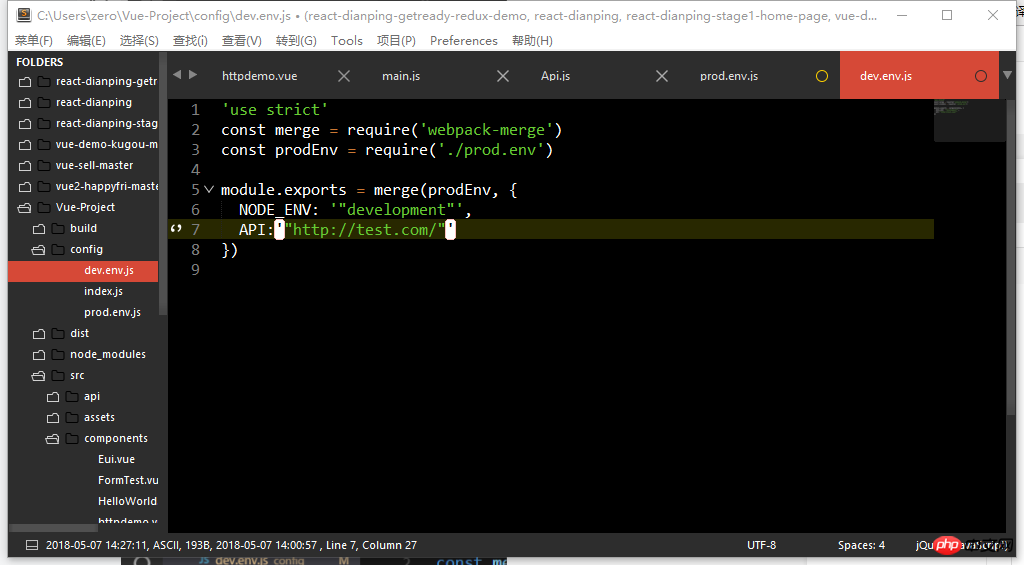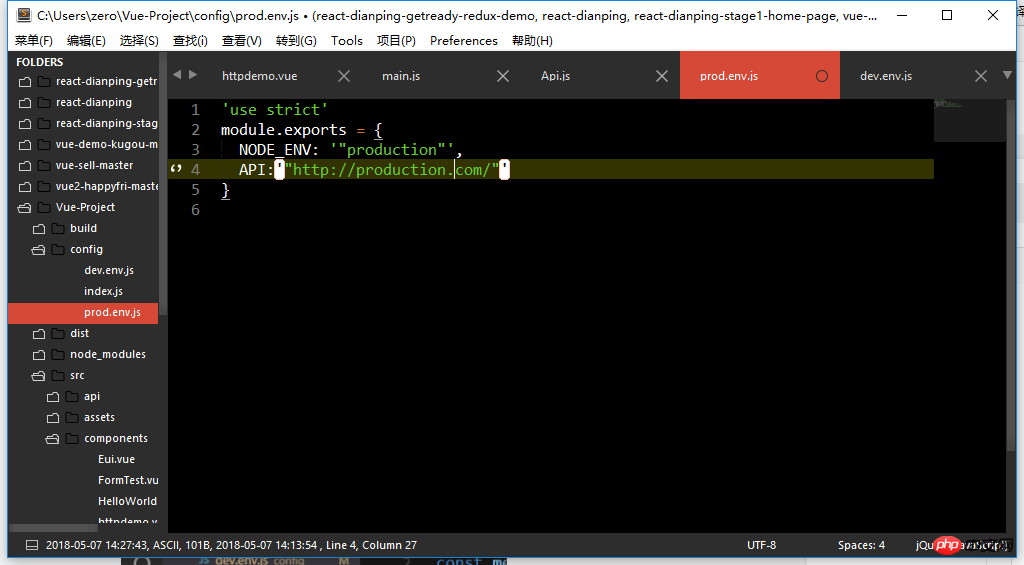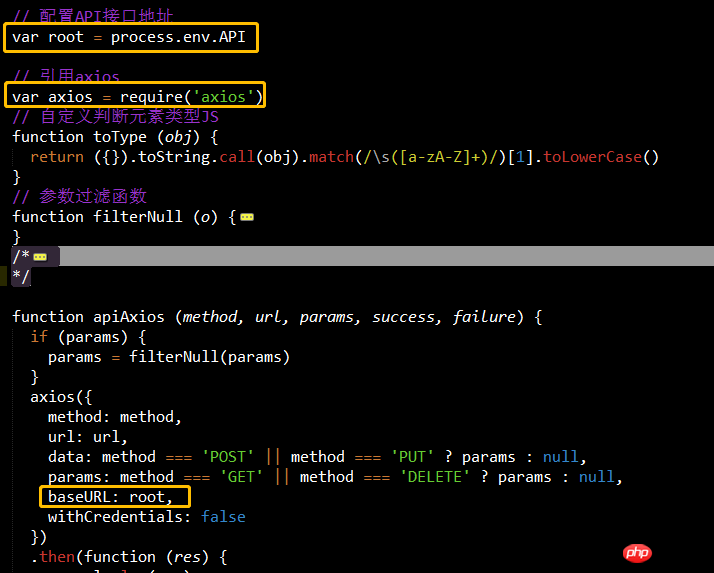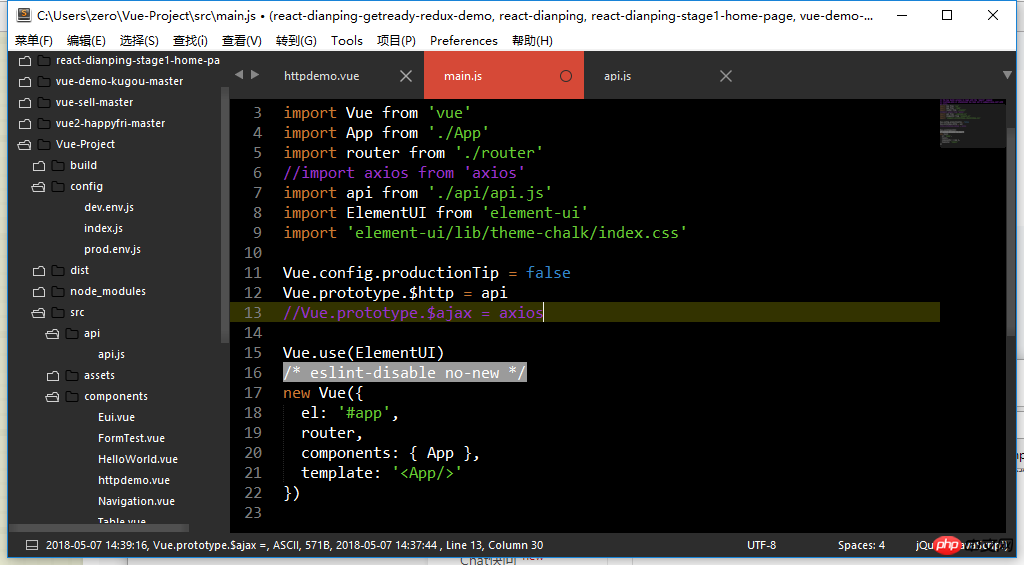
This time I will show you how to use vue axios to configure the interface address for the production and release environment. What are the precautions for using vue axios to configure the interface address for the production and release environment? The following is a practical case. Let’s take a look.
This project is a project built by vue-cli1. Set different interface addresses
Find the following file/config/dev.env.js/config/prod.env After .js, add the interface address domain name configuration. The added file content is as follows

# #2. In the axios file you re-encapsulated (api/api.js), splice the configured interface address as baseURL into the interface path
 For detailed api.js file, please refer to the following code. You can make adjustments according to the coding habits of your company’s project team
For detailed api.js file, please refer to the following code. You can make adjustments according to the coding habits of your company’s project team
// 配置API接口地址
var root = process.env.API
// 引用axios
var axios = require('axios')
// 自定义判断元素类型JS
function toType (obj) {
return ({}).toString.call(obj).match(/\s([a-zA-Z]+)/)[1].toLowerCase()
}
// 参数过滤函数
function filterNull (o) {
for (var key in o) {
if (o[key] === null) {
delete o[key]
}
if (toType(o[key]) === 'string') {
o[key] = o[key].trim()
} else if (toType(o[key]) === 'object') {
o[key] = filterNull(o[key])
} else if (toType(o[key]) === 'array') {
o[key] = filterNull(o[key])
}
}
return o
}
function apiAxios (method, url, params, success, failure) {
if (params) {
params = filterNull(params)
}
axios({
method: method,
url: url,
data: method === 'POST' ? params : null,
params: method === 'GET' ? params : null,
baseURL: root,
withCredentials: false
})
.then(function (res) {
console.log(res);
return;
if (res.data.success === true) {
if (success) {
success(res.data)
}
} else {
if (failure) {
failure(res.data)
} else {
window.alert('error: ' + JSON.stringify(res.data))
}
}
})
.catch(function (err) {
let res = err.response
if (err) {
window.alert('api error, HTTP CODE: ' + res.status)
return
}
})
}
// 返回在vue模板中的调用接口
export default {
get: function (url, params, success, failure) {
return apiAxios('GET', url, params, success, failure)
},
post: function (url, params, success, failure) {
return apiAxios('POST', url, params, success, failure)
}
}3. Modify main.js, Introduce your own repackaged axios file (api/api.js). The modified file is as shown below

4. Call it on the page and test whether it takes effect. After the development environment is adjusted, check whether the official environment also takes effect after building.Directly call the ajax request
export default {
created(){
this.$http.post('Web/test',null, res => {
console.log(res)
})
}
}I believe you have mastered the method after reading the case in this article. For more exciting information, please pay attention to other related articles on the php Chinese website!
Recommended reading:
Detailed explanation of the steps to use the JS callback functionJS common algorithms accumulation, iteration, exhaustion, Recursive implementation (with code)The above is the detailed content of How to use vue axios to configure interface addresses for production and release environments. For more information, please follow other related articles on the PHP Chinese website!
 What does WeChat clone mean?
What does WeChat clone mean?
 netframework
netframework
 How to open the terminal window in vscode
How to open the terminal window in vscode
 What are the free php virtual hosts abroad?
What are the free php virtual hosts abroad?
 What is the use of java
What is the use of java
 What is a relational database
What is a relational database
 How to make pictures scroll in ppt
How to make pictures scroll in ppt
 What are the seven principles of PHP code specifications?
What are the seven principles of PHP code specifications?
 Detailed explanation of nginx configuration
Detailed explanation of nginx configuration




